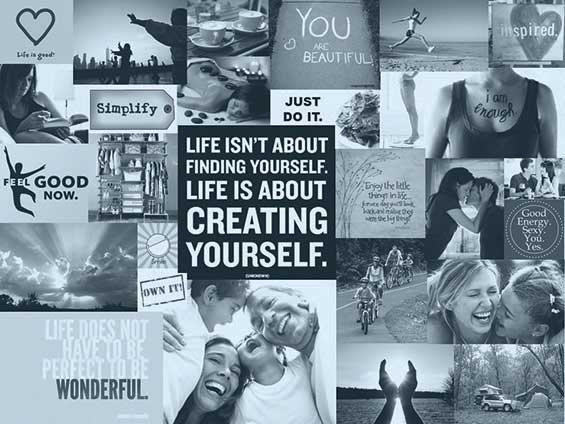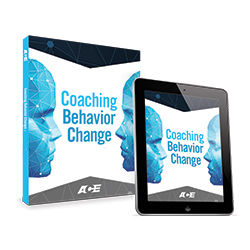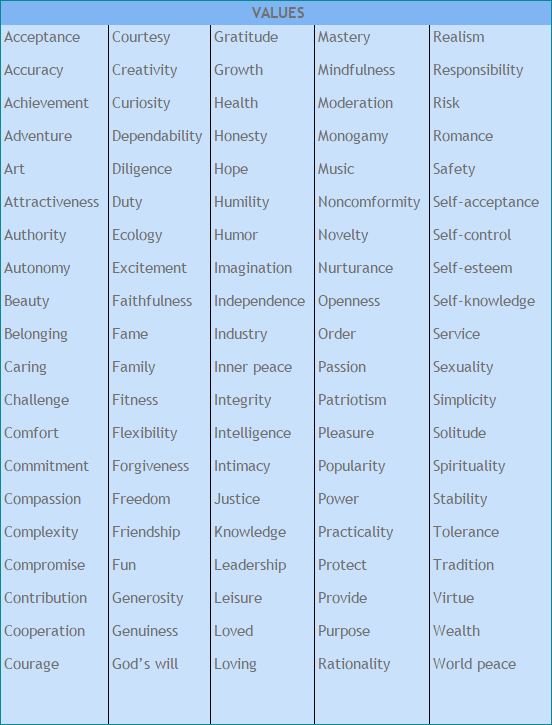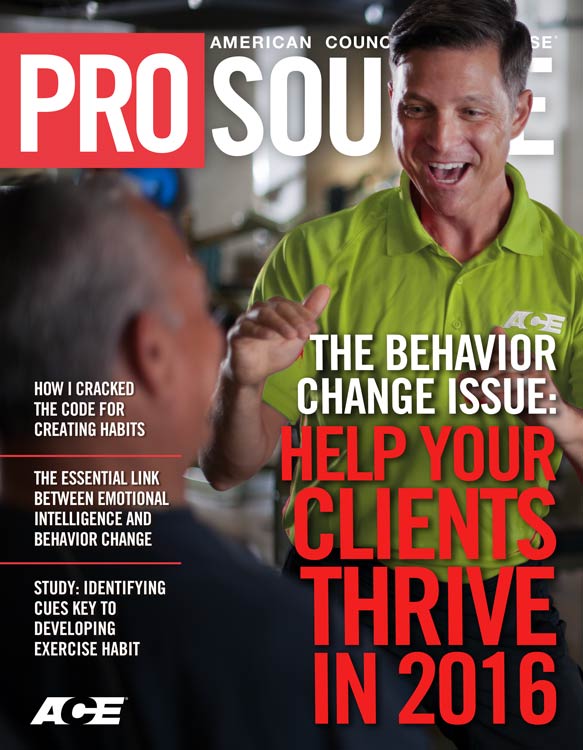
Learning Objectives
After reading this, you will be able to:
- Identify a client’s values and use them as a framework for future goal setting
- Help a client look to the future through the process of visioning
- Describe various tools and techniques coaches may use to support visioning
- Help a client craft a personal mission statement
Most personal training, health coaching or nutrition counseling sessions begin in a similar way. A client comes looking to lose weight or improve fitness, and the health professional helps the client establish goals to do just that. Then, the client may or may not follow those recommendations. Within a few months many people have either achieved the identified goal and are ready for “the next one,” or, more often, have fallen back into their old patterns.
Sound familiar? As a health and fitness professional, you may be able to help guide clients toward more meaningful and sustained changes by stepping back and helping clients take a look at the big picture: What motivates and inspires this client? What is the big “dream” he or she would like to see or accomplish in the next one, five or even 10 years? What key values drive him or her? These questions will reveal a lot more than fitness, nutrition and health goals. This deeper understanding may put those types of goals in context and help to set the stage for a more meaningful connection and a greater impact.
A Values Interview
In your role as a health and fitness professional, you help clients increase awareness in their process of behavioral change. As such, devoting a coaching session to exploring a client’s values can go a long way to better understanding the client and also in evoking a client’s own motivation and commitment to change. Miller and Rollnick (2013) recommend that coaches complete a values interview with their clients. This can include asking open-ended questions ranging from “What do you care most about in life?” to asking clients if they were to write a “mission statement” for their lives, how would they describe their goals and purpose in life? One structured way of helping explore a client’s values is through a personal values card sort (see sidebar).

Coaching Behavior Change
Portions of this article are adapted from Coaching Behavior Change (American Council on Exercise, 2014). Health and fitness professionals interested in learning more about how to incorporate values and visioning in their work may consider earning an ACE Behavior Change Specialty Certification. Available for purchase as both an eBook and hard copy, Coaching Behavior Change was created by ACE to help practitioners from a wide range of fields develop the hands-on, practical skills necessary to lead diverse clients and patients to sustainable, healthy change.
From Values to Vision
Once a client has expressed key values, you can help the client create a vision of what the future might look like using those fundamental values as the foundation of that vision. The section at the end of this article highlights some practical activities you might do with a client who is mapping out a plan to improve health and overall happiness and quality of life
Crafting the Personal Mission Statement
The next stage in this process includes using the client’s values and vision of what the desired future looks like to craft a personal mission statement. The idea of a personal mission statement was popularized by the late Stephen Covey, author of The 7 Habits of Highly Effective People (2013), and recently highlighted in a New York Times article by Tara Parker-Pope (2015). Covey argued persuasively that a mission statement helps to establish a compass and a pathway. It aligns with the second habit of “[beginning] with the end in mind.”
Here’s how you might go about helping a client craft a mission statement:
Step 1. Consider the client’s stated key values and vision explored above and ask open-ended questions and use reflections to explore more deeply how this helps guide the client in how he or she lives.
Step 2. Ask the client to begin to draft a personal mission statement. There is no one right way to do this. It does not need to be a long, formal document or resemble a company mission statement. It could be a single word, phrase or image. There likely will be many drafts and renditions of this mission statement.
Step 3. Use the mission statement as an ever-present guide. This mission statement serves as an anchor and a compass that can help a client to prioritize decisions and actions, and work to align goals and actions with a bigger sense of purpose.
And Now We Can Discuss Those Goals
Guiding clients through the process of identifying their most important values and crafting a personal mission statement to serve as a framework as they pursue personal and health goals serves as a critical link between increasing awareness of what is needed for change and beginning the planning process of achieving it.
Values Card Sort
In the values card sort, a client is given a list of 100 values (see list, below), each on its own card, and the client sorts the cards into piles based on the degree of importance of each value to the client. He or she may then identify five to 10 values that are of most importance. From here, you and your client can further explore these values and use them as a foundation in discussing the client’s vision for the future. For example, you might ask: “How do these values guide your personal and professional goals?” The value card sort activity is available here.

Strategies to Help Turn a Vision into Reality
Life coach and ACE Certified Health Coach Billie Frances, M.F.T., ACE Certified Health Coach and Personal Trainer Lee Jordan, and registered dietitian and ACE Certified Health Coach and Personal Trainer Gina Crome recommend the following practical activities, which can help translate the abstract process of exploring values and vision into concrete actions to help a client move forward in making a significant life change.
Listen
Gina Crome focuses her work on honing listening skills to help bring out a client’s values and vision for the future by asking open-ended questions that “evoke introspection and foster discussion.” Her advice to health and fitness professionals:
Less is more...meaning that the less I talk, the more my client talks. And if you really want to know what your client values most, there’s a good chance he or she won’t share it with you as long as you do most of the talking during a coaching session. Keep in mind that meaningful lifestyle changes take time. By approaching each coaching session as an opportunity to learn about your client as opposed to injecting your own agenda, you’ll gain better insight into your client as a whole and the areas that impact his or her goals.
You can use communication techniques like open-ended questions and reflections to help draw out a client’s vision of change. For instance, if your client says, “I really want to get fit so that I can keep up with my kids. Right now I get so exhausted when I’m with them,” you could follow it up with a reflection such as, “Being able to be active with your kids is really important to you.” The client may agree or disagree with this statement, but either way, you have helped the client move closer to identifying key values. The client’s vision might be that the family regularly spends time together being active.
Dream
Lee Jordan, who works primarily with individuals aiming to lose 100 pounds or more, helps clients tap into their dreams. Not what their “dreams” should be, but what they actually are:
What a person values the most about themselves and others, what their life’s dream is, is the fuel to move down the path to sustainable change. My work is around helping clients determine what their “dream” is….I am a bit like a miner, helping them move the dirt to find the gold. They usually start with what they think they “should” value—what their goals “should” be and things like a number on the scale as a goal—until we finally land at what they really value, what they really desire, their unlimited dream. I say unlimited because often, due to past “failures” and/or negative self-images, a person doesn’t dare to dream big—to seek their true “fullest life.” As we get to their real dream—and it’s a process, over time—I find it works well to have a picture, a visual representation.
Journal
Billie Frances recommends journaling. Clients may find it helpful to write out their thoughts, ideas, progress, questions or answers to key questions. Journals are typically not shared. Journaling can include stream-of-thought writing, list-making, drawings or responses to some key questions, such as:
- How can I best use my energy?
- If I were 5 percent healthier, I would…
- What will ground me when the going gets tough?
- What are the pros and cons of this situation?
Mindfulness and Meditation
Frances also recommends the practice of mindfulness. A client may begin with simple meditation, such as sitting quietly and focusing only on the breath. Meditation can also include anything that allows for a singular focus, such as walking with awareness, listening to music, dancing or being in nature. Frances frequently incorporates mindfulness practices into her work, though she notes that it is important that coaches always act within their level of comfort and training for these activities.
A Vision Board
In addition to words of affirmation and contemplation, Frances notes that some clients find it helpful to create a pictorial representation of their desired future. Vision boards can often answer in pictures what cannot readily be put into words alone. Vision boards often include:
- Drawings
- Collages
- Collections of words or symbols
Possible subjects for a vision board include:
- What nurtures me?
- What do I love/value?
- My life in 10 years
- The ideal scene for a healthy life
- My home life, family life, love life, career
Jordan also endorses the use of a vision board:
This exercise really opens doors and helps [clients] see beyond a number on a scale or fitting into a pair of pants. I have them build the collage using their phones or computers, which reduces the barrier to entry of creation, expands their choices and provides motivation that can be drawn on instantly. The pictures they select more naturally leads to authentic communication, empowers them and positions me more as a facilitator than an inquisitor. Later, we are able to share the pictures via text as a celebration of a particular choice or action or as a reminder of why we are choosing to do something that is immediately not gratifying as a step closer to the unlimited dream.
References and Resources
American Council on Exercise (2014). Coaching Behavior Change. San Diego, Calif.: American Council on Exercise
Covey, S. (2013). The 7 Habits of Highly Effective People: Powerful Lessons in Personal Change (deluxe 25th anniversary edition). New York: Simon & Schuster.
Miller, W. and Rollnick, S. (2013). Motivational Interviewing: Helping People Change. New York: Guilford Press.
Parker-Pope, T. (January 5, 2015). Creating a New Mission Statement. The New York Times.





 by
by 




